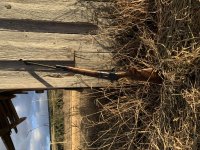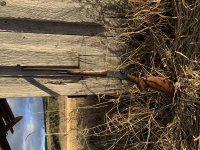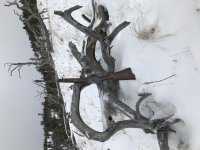444 Magnum
Member
- Joined
- Jan 6, 2011
- Messages
- 1,183
- Reaction score
- 7,165
I pulled the 71’s out of the safe this week and I thought I’d share some pics and a brief history.
The Winchester 1886 was Winchester’s big bore, tube fed, lever rifle beginning in 1886 and ending in the 1932-1935 time period. (some including Madis say 1932 with parts cleanup for several years- other sources say 1935).
The Winchester 1886 was available in numerous calibers (10 or more) ranging from .33 wcf up to the .50-110’s.
The 1886 was truly a customizable rifle with customers having choices in caliber, barrel length, tube length, barrel shape (round, part round or octagon), and type (rifle, carbine, or musket). Other choices included the type of sights, quality and finish of wood, butt style, grip style, checking, engraving, receiver finish, etc. The possibilities were numerous and Winchester was willing to accommodate- for a price of course.
By the 1920’s, Winchester began pulling back on custom builds. The Model 53, a continuation of the Model 1892, was the first catalogue offering with limited options. Others would follow such as the .22’s in models 61, 62, and 63. The Model 1894 would eventually just become the Model 94 available in .30-30 carbine only, etc.
The .33 wcf was introduced in the Model 1886 in 1903. By 1920, it was the only cartridge in which the 1886 was being produced and was offered in the lightweight rifle. Other calibers were available as parts were cleaned up, but the .33 wcf barrel was the only one being produced from 1920 to 1928. The .45-70 was introduced along with the 33 wcf in the lightweight rifle from 1928-1931. Production ended soon thereafter.
Here’s a typical 1886 in .38-56 beside a lightweight .33 with a climbin' Lyman. The differences are significant.


OK, maybe it’s not a “typical” 1886, but it was standard for the time.
In 1935, the Winchester 71 was introduced in .348 wcf. It was a continuation of the 1886 lightweight rifle. There were a few mechanical changes. Pistol grips and shotgun style butt stocks were now standard with a semi-beavertail forearm. Swivels and slings also became standard. Here's the 71 next to the lightweight 33.


The Model 71 was independently serialized beginning with 1 and ending with 47,254 in 1958. Although production began in late 1935, only 4 rifles were completed that year. In 1936, some 7,812 rifles were completed. My earliest rifle is serial #1432, likely completed in the first few months of 1936.

The .348 wcf offered enhanced performance over the .33 wcf of approximately 300 f.p.s with the same bullet weight. Factory loadings were available in 150, 200, and 250 grain bullet weights. Over time, the 150 and 250 grain loadings were dropped and the 200 grain bullet became standard. Factory loads pushed the .348” 200 grain bullet at approximately 2500 f.p.s. from the muzzle. A very capable cartridge for short and medium range hunting.

The background picture. My great grandfather and great grandmother in the 1920’s. That’s his brother in the background pointing the 1905 M&P---OK, this is now officially a S&W thread.

Very few changes were made to the Model 71 over its 23 year production life. The two most significant changes were barrel length and upper tang length.
The standard barrel was 24” with a 2/3 mag tube. In 1937, a 20” short barrel rifle was introduced but it was discontinued by 1947 due to a lack of enthusiasm. These short barreled 71’s became known as 71 “carbines” to collectors and are sought after.
I found both of these “carbines” at the same auction- one long tang deluxe and one short tang deluxe. The long tang deluxe carbine has seen quite a bit of carry in its lifetime—but it’s still a deluxe carbine. The price was right and I haven’t seen them very often.


The upper tang on the original Model 71 was 3 7/8” in length. Between the serial number range of approximately 12,500 to 17,000 (1937-1939), the length of the upper tang was shortened by 1” and the long tangs were phased out.

This shortening of the upper tang produced a noticeable difference in the comb and wrist of the stock.

One other change that affected all Winchester rifles was the change in the barrel bluing procedure which occurred in 1939. Before 1939, the barrels were browned or rust blued. The barrels were plugged at the muzzle prior to the rust bluing process so as not to rust the finished, rifled barrel. These rust blued barrels are distinguishable by the straight cut muzzle in the white. After 1939, a more cost-effective dip bluing process known as Du-Lite blue was used. At this time, muzzles were crowned and blued. Here’s a picture showing the two. I think most of the bluing has been shot off this crowned muzzle.

Standard rear sights included both open sporting sights and bolt peep sights. A long ramp sight with cover was standard on the front.

Deluxe models were available with a more pronounced, capped pistol grip. Both the pistol grip and the forearm were checked on the deluxe models. Straight grain black walnut was standard on all rifles.


Here’s my accumulation of 71’s. Most of mine have been carried and used-some more than others-but that's what they were made for. I need to find a couple of hood covers for two of them. Detachable swivels have been removed for storage and tucked away.

I concentrated mostly on long tang, bolt peep, deluxe rifles without any extra "holes". Along the way, I did acquire one standard, short tang rifle that was too cheap to pass up.



My friend used to say that a rifle without ammo was nothing more than a club. The .348 cartridge has been hard to find in the past. Winchester and Hornady do limited runs in 200 grain bullets. BuffaloBore has a load in 250 grains. I have my own stockpile of ammo and reloading supplies. “I’m loaded for bear.”

These rifles became known to some as “the smoothest lever-action ever built.” You’ll get no argument from me. They are slick and the craftsmanship is excellent.
Thanks for letting me share one of my other firearm indulgences.
As always, if you’ve got ‘em, post ‘em.
Steve
***Thanks to S&Wchad for consolidated what was 4 posts. Its easier to follow now.
The Winchester 1886 was Winchester’s big bore, tube fed, lever rifle beginning in 1886 and ending in the 1932-1935 time period. (some including Madis say 1932 with parts cleanup for several years- other sources say 1935).
The Winchester 1886 was available in numerous calibers (10 or more) ranging from .33 wcf up to the .50-110’s.
The 1886 was truly a customizable rifle with customers having choices in caliber, barrel length, tube length, barrel shape (round, part round or octagon), and type (rifle, carbine, or musket). Other choices included the type of sights, quality and finish of wood, butt style, grip style, checking, engraving, receiver finish, etc. The possibilities were numerous and Winchester was willing to accommodate- for a price of course.
By the 1920’s, Winchester began pulling back on custom builds. The Model 53, a continuation of the Model 1892, was the first catalogue offering with limited options. Others would follow such as the .22’s in models 61, 62, and 63. The Model 1894 would eventually just become the Model 94 available in .30-30 carbine only, etc.
The .33 wcf was introduced in the Model 1886 in 1903. By 1920, it was the only cartridge in which the 1886 was being produced and was offered in the lightweight rifle. Other calibers were available as parts were cleaned up, but the .33 wcf barrel was the only one being produced from 1920 to 1928. The .45-70 was introduced along with the 33 wcf in the lightweight rifle from 1928-1931. Production ended soon thereafter.
Here’s a typical 1886 in .38-56 beside a lightweight .33 with a climbin' Lyman. The differences are significant.
OK, maybe it’s not a “typical” 1886, but it was standard for the time.
In 1935, the Winchester 71 was introduced in .348 wcf. It was a continuation of the 1886 lightweight rifle. There were a few mechanical changes. Pistol grips and shotgun style butt stocks were now standard with a semi-beavertail forearm. Swivels and slings also became standard. Here's the 71 next to the lightweight 33.
The Model 71 was independently serialized beginning with 1 and ending with 47,254 in 1958. Although production began in late 1935, only 4 rifles were completed that year. In 1936, some 7,812 rifles were completed. My earliest rifle is serial #1432, likely completed in the first few months of 1936.
The .348 wcf offered enhanced performance over the .33 wcf of approximately 300 f.p.s with the same bullet weight. Factory loadings were available in 150, 200, and 250 grain bullet weights. Over time, the 150 and 250 grain loadings were dropped and the 200 grain bullet became standard. Factory loads pushed the .348” 200 grain bullet at approximately 2500 f.p.s. from the muzzle. A very capable cartridge for short and medium range hunting.
The background picture. My great grandfather and great grandmother in the 1920’s. That’s his brother in the background pointing the 1905 M&P---OK, this is now officially a S&W thread.
Very few changes were made to the Model 71 over its 23 year production life. The two most significant changes were barrel length and upper tang length.
The standard barrel was 24” with a 2/3 mag tube. In 1937, a 20” short barrel rifle was introduced but it was discontinued by 1947 due to a lack of enthusiasm. These short barreled 71’s became known as 71 “carbines” to collectors and are sought after.
I found both of these “carbines” at the same auction- one long tang deluxe and one short tang deluxe. The long tang deluxe carbine has seen quite a bit of carry in its lifetime—but it’s still a deluxe carbine. The price was right and I haven’t seen them very often.
The upper tang on the original Model 71 was 3 7/8” in length. Between the serial number range of approximately 12,500 to 17,000 (1937-1939), the length of the upper tang was shortened by 1” and the long tangs were phased out.
This shortening of the upper tang produced a noticeable difference in the comb and wrist of the stock.
One other change that affected all Winchester rifles was the change in the barrel bluing procedure which occurred in 1939. Before 1939, the barrels were browned or rust blued. The barrels were plugged at the muzzle prior to the rust bluing process so as not to rust the finished, rifled barrel. These rust blued barrels are distinguishable by the straight cut muzzle in the white. After 1939, a more cost-effective dip bluing process known as Du-Lite blue was used. At this time, muzzles were crowned and blued. Here’s a picture showing the two. I think most of the bluing has been shot off this crowned muzzle.
Standard rear sights included both open sporting sights and bolt peep sights. A long ramp sight with cover was standard on the front.
Deluxe models were available with a more pronounced, capped pistol grip. Both the pistol grip and the forearm were checked on the deluxe models. Straight grain black walnut was standard on all rifles.
Here’s my accumulation of 71’s. Most of mine have been carried and used-some more than others-but that's what they were made for. I need to find a couple of hood covers for two of them. Detachable swivels have been removed for storage and tucked away.
I concentrated mostly on long tang, bolt peep, deluxe rifles without any extra "holes". Along the way, I did acquire one standard, short tang rifle that was too cheap to pass up.
My friend used to say that a rifle without ammo was nothing more than a club. The .348 cartridge has been hard to find in the past. Winchester and Hornady do limited runs in 200 grain bullets. BuffaloBore has a load in 250 grains. I have my own stockpile of ammo and reloading supplies. “I’m loaded for bear.”
These rifles became known to some as “the smoothest lever-action ever built.” You’ll get no argument from me. They are slick and the craftsmanship is excellent.
Thanks for letting me share one of my other firearm indulgences.
As always, if you’ve got ‘em, post ‘em.
Steve
***Thanks to S&Wchad for consolidated what was 4 posts. Its easier to follow now.
Last edited by a moderator:




